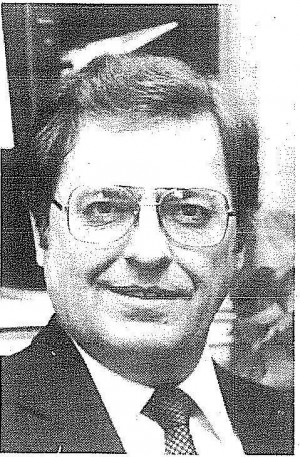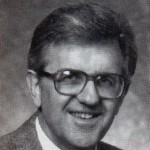as printed in the Journal of Mennonite Studies Vol. 9, 1991

Readers of this journal are well acquainted with the writings of Al Reimer. In addition to contributing a number of articles on Mennonite literature – his fifth appears in this issue – he has been a member of the Journal’s editorial committee since its inception in 1983 and has evaluated and edited a large number of the papers that have been accepted for publication. Because of this important role, and his larger literary contribution to the Mennonite community, he was recently invited to be co-editor of the Journal.
At the same time that Al accepted this new appointment he announced that he was retiring from his teaching position in the English department at The University of Winnipeg. Since Al has always impressed us with his youthful vigor and intellectual agility this announcement caught us by surprise. Actually, while he is not at the age of normal retirement, he is closer to it than many might have realized. He is, after all, a survivor of the Great Depression of the 30s, of World War 11, of a long-term marriage with three children, of twenty years of formal schooling and thirty years of university teaching. At various times he has been a stock broker, an opera-singer-intraining, a hotel desk clerk, a paper-mill operator, radio and T.V. commentator, magazine editor, novelist, short-story writer, public speaker, a stand-up comedian (both on stage and off), a travel tour host, and a charmingly erratic golfer. Though he has lived long and well, he has remarkably few lines to show for it.
There are several reasons why Al decided to retire “early.” First, he is not greedy. More years of teaching would have added to his pension, but he saw himself living quite adequately on the pension he had already accumulated. With wife Joan as financial advisor this may indeed turn out to be true. Second, Joan’s health caused both of them to consider more winter months spent in warm places like Arizona. Third, after thirty years of teaching a sense of déjà vu had set in – not burnout, but ennui. Fourth, and probably most important, teaching was interfering with dozens of other things that he wanted to do. Retirement was attractive not because it meant release from creative, intellectual work but because it held out the prospect of even greater opportunities for such work. Therefore we welcome Al into his “retirement” years. We expect to benefit even more from his immense literary and oratorical talents.
The Mennonite community can be grateful that in the early seventies, following a trip to the former Mennonite colonies of southern Russia, A1 decided to reclaim his Mennonite heritage. Somewhere in the Russian steppes, among the ruins of former Mennonite homes and schools he caught a whiff of a people who had once possessed heroic dreams and had managed, in the most unlikely of circumstances, to translate those dreams into viable, vibrant communities. His imagination stirred, he returned to Canada and made the decision to link his life with that heritage. He had made that most startling of all human discoveries: who he really was. He was, he concluded, not primarily a citizen of a country called Canada, or a member of an amorphous intellectual or artistic community, but a Mennonite from Steinbach, half Reimer, half Kehler, a descendent of these families and of their forebears in Russia, and filled with all the dreams and hurts that such a history produces.
A self-discovery of this kind does not settle the great issues of life. On the contrary, it focuses those issues and forces one to come to terms with them in a new way. Al chose to locate himself in history, with a particular group of people. This hasn’t necessarily made him happier. Troubling questions arise immediately. Who really were those people with whom he now identifies, and what are they really like now, in their modern guise in Canada? One is no longer dealing mainly with abstract theories and aesthetic ideals, but with very human people who are capable of crushing as well as nurturing the human spirit. (This may explain why many Mennonite adherents are tempted to flee not only into apostasy but to other more nebulous religious groups without historical “baggage.” It is easier to embrace a general idea than a human brother or sister). Answers to such questions require a deeper historical search, and a willingness to participate in the current life of the community. While such search and participation should generate new insights, they inevitably add to one’s responsibilities as well. Al has confessed that sometimes, early in the morning, he looks dolefully in the mirror and asks himself why he ever took on the burden of such participation.
To the artist or scholar – the “truthful” observers of society -involvement in a religious community poses an additional problem: how, in effect, to take “sides” with a community while examining it truthfully. Such an examination calls for objectivity, and this in turn seems to require neutrality and distance. This dilemma is not easily resolved, if at all. Some of our scholars implicitly recognize it when they praise “outside” scholars for their unique, critical assessments of Mennonite life – implying that this cannot be done by those within the community. However, while the critiques of outsiders should always be welcomed, Al Reimer’s commitment and work show us that truth may also emerge from within. For this to happen, however, at least two things are necessary. First, there has to be a qualified commitment to the community (a certain distance is necessary). While the community is important to one’s identity, it is not synonymous with it. Neither should one adopt the role of protector to the community, as one who is called to lead or save it. The role of a humble, even tentative, participant is more appropriate. Second, there has to be a wholehearted commitment to truth. The artist/scholar’s attempt to understand and describe life as experienced in the community, both past and present, must be conducted without glances over the shoulder. Where one looks for the truth, what one discovers and how it is reported should not be affected in any fundamental way by its impact on others. Such a concern for others is frequently justified in the name of love, but it usually masks a cowardice in the face of the truth. Truth alone makes us free to love.
For almost twenty years now Al Reimer has enriched and entertained us by searching for, and depicting the basic features of Mennonite life in the “truthful” way just described. His efforts have been prodigious. He is best known for his 1985 novel My Harp Is Turned to Mourning, which, after sales of about 4,000 copies, has virtually entered the best-seller lists in Canada. For those who love history more than fiction Al always had a ready response: “If it’s truth you want, you are more likely to find it in fiction than in so-called ‘factual’ history.” Several readers unintentionally supported his contention. They apparently found his treatment of Russian Mennonite life so real that they insisted they had actually known some of his fictional characters. In preparation for this novel Al translated and edited two Russian Mennonite novels by other authors: A Russian Dance of Death by Dietrich Neufeld, and No Strangers in Exile by Hans Harder. Both found a wide reading audience. In addition to this he was editor of the Mennonite Mirror for nine years, and chief editor for the Mennonite Literary Society of Winnipeg, in whose publication of 16 books he took an active, creative hand. Numerous writers have benefitted from his painstaking editorial assistance, always offered generously without remuneration. In 1985 he also co-edited, with Harry Loewen, Visions and Realities: Essays, Poems and Fiction Dealing With Mennonite Issues.
One of the surprises in his literary career has been his growing love for, and competence in, Low German. His linguistic skills, honed at Yale and through numerous university classes, were brought to bear on this unique language in a most fruitful way. In the eighties he assembled a group of Low German scholars from across Canada to create order out of the chaos of Low German orthography. This attempt was not entirely successful – some of the compromises agreed to voluntarily by everyone were later challenged and blamed on the chairman – but it did provide a more consistent structure for the language and gave a major impetus to new writing and publication. Al himself co-edited (with Anne Reimer and Jack Thiessen) an anthology of Low German verse and fiction – A Sackful of Plautdietsch. Later he served as Consulting and Revising Editor for a new Low German dictionary compiled by Herman Rempel. Recently he completed the editing of all Arnold Dyck’s Low German writings in two large volumes that form part of a new four-volume edition of the author’s works. For many years now he has been invited to Mennonite high schools and colleges in the U.S. and Canada to read from his own works and from Low German sources. He loves performance, something that puzzles those Mennonites of a more studied humility.
Whether in his private study in Winnipeg, or in his trailer in Arizona, Al Reimer is destined to work out the “truth” in his own unique personal and literary way. Down the road his novel on Steinbach (or whatever he calls the cauldron of his youth) will hopefully combine with James Urry’s study of the village of Grunthal to help us understand, and enjoy, Mennonite life as never before. In the hands of people like this, truth will emerge, painfully and joyfully, whether from the inside or out.

Roy Vogt
St. Paul’s College
University of Manitoba
